Nutrition Research: Diet, Fiber, and Cardiovascular Disease in Canada
VerifiedAdded on 2022/09/10
|11
|2599
|28
Report
AI Summary
This research paper presents a quantitative study investigating the effectiveness of nutritional interventions, specifically nutrition education and increased dietary fiber intake, in reducing cholesterol levels among Canadians diagnosed with cardiovascular disease. The study employs a randomized controlled trial (RCT) design, comparing an experimental group receiving nutritional interventions to a control group. The research includes a review of relevant literature highlighting the prevalence of cardiovascular diseases and hypercholesterolemia in Canada, as well as the benefits of fiber and nutrition education. The study's aims include determining the impact of these interventions on cholesterol levels and assessing the prevalence of hypercholesterolemia. The methodology involves random sampling of 200 participants, with specific inclusion and exclusion criteria, and the use of student's t-tests and percentages for data analysis. The paper also addresses methods for minimizing bias, ethical considerations, and plans for research dissemination through peer-reviewed publications, educational videos, and media outreach. The expected outcome is a reduction in cholesterol levels and decreased risk of cardiovascular diseases due to the nutritional interventions.
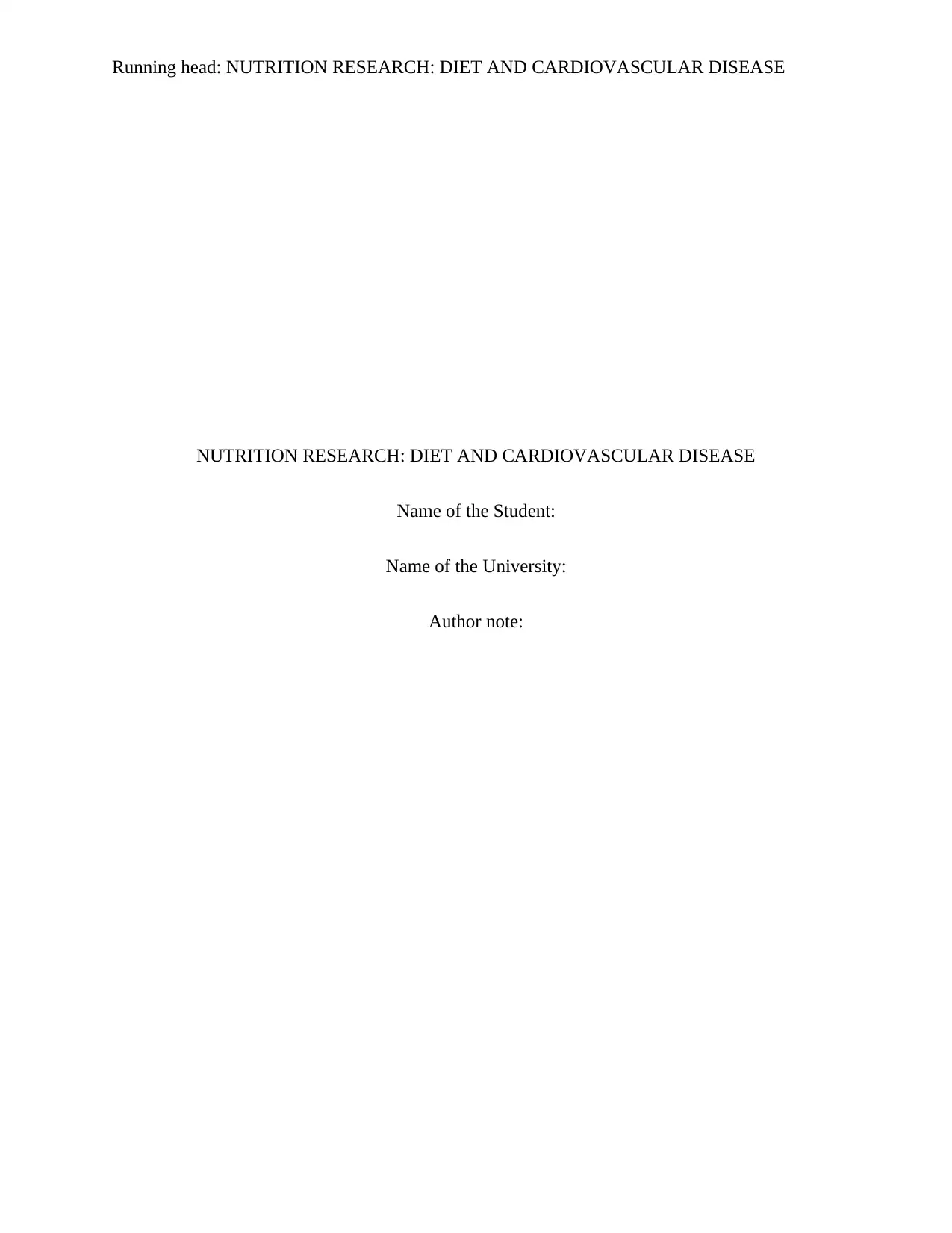
Running head: NUTRITION RESEARCH: DIET AND CARDIOVASCULAR DISEASE
NUTRITION RESEARCH: DIET AND CARDIOVASCULAR DISEASE
Name of the Student:
Name of the University:
Author note:
NUTRITION RESEARCH: DIET AND CARDIOVASCULAR DISEASE
Name of the Student:
Name of the University:
Author note:
Paraphrase This Document
Need a fresh take? Get an instant paraphrase of this document with our AI Paraphraser
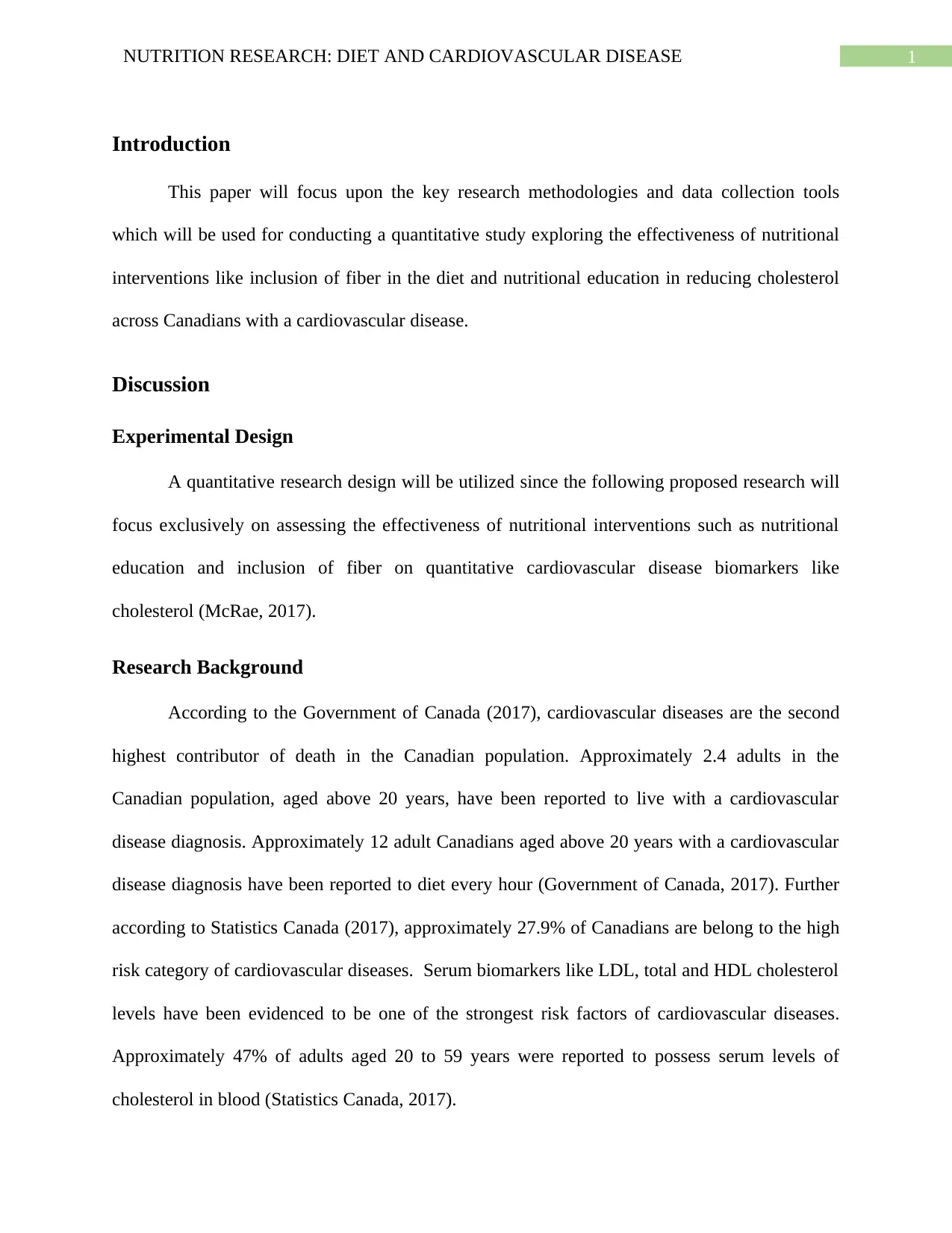
1NUTRITION RESEARCH: DIET AND CARDIOVASCULAR DISEASE
Introduction
This paper will focus upon the key research methodologies and data collection tools
which will be used for conducting a quantitative study exploring the effectiveness of nutritional
interventions like inclusion of fiber in the diet and nutritional education in reducing cholesterol
across Canadians with a cardiovascular disease.
Discussion
Experimental Design
A quantitative research design will be utilized since the following proposed research will
focus exclusively on assessing the effectiveness of nutritional interventions such as nutritional
education and inclusion of fiber on quantitative cardiovascular disease biomarkers like
cholesterol (McRae, 2017).
Research Background
According to the Government of Canada (2017), cardiovascular diseases are the second
highest contributor of death in the Canadian population. Approximately 2.4 adults in the
Canadian population, aged above 20 years, have been reported to live with a cardiovascular
disease diagnosis. Approximately 12 adult Canadians aged above 20 years with a cardiovascular
disease diagnosis have been reported to diet every hour (Government of Canada, 2017). Further
according to Statistics Canada (2017), approximately 27.9% of Canadians are belong to the high
risk category of cardiovascular diseases. Serum biomarkers like LDL, total and HDL cholesterol
levels have been evidenced to be one of the strongest risk factors of cardiovascular diseases.
Approximately 47% of adults aged 20 to 59 years were reported to possess serum levels of
cholesterol in blood (Statistics Canada, 2017).
Introduction
This paper will focus upon the key research methodologies and data collection tools
which will be used for conducting a quantitative study exploring the effectiveness of nutritional
interventions like inclusion of fiber in the diet and nutritional education in reducing cholesterol
across Canadians with a cardiovascular disease.
Discussion
Experimental Design
A quantitative research design will be utilized since the following proposed research will
focus exclusively on assessing the effectiveness of nutritional interventions such as nutritional
education and inclusion of fiber on quantitative cardiovascular disease biomarkers like
cholesterol (McRae, 2017).
Research Background
According to the Government of Canada (2017), cardiovascular diseases are the second
highest contributor of death in the Canadian population. Approximately 2.4 adults in the
Canadian population, aged above 20 years, have been reported to live with a cardiovascular
disease diagnosis. Approximately 12 adult Canadians aged above 20 years with a cardiovascular
disease diagnosis have been reported to diet every hour (Government of Canada, 2017). Further
according to Statistics Canada (2017), approximately 27.9% of Canadians are belong to the high
risk category of cardiovascular diseases. Serum biomarkers like LDL, total and HDL cholesterol
levels have been evidenced to be one of the strongest risk factors of cardiovascular diseases.
Approximately 47% of adults aged 20 to 59 years were reported to possess serum levels of
cholesterol in blood (Statistics Canada, 2017).
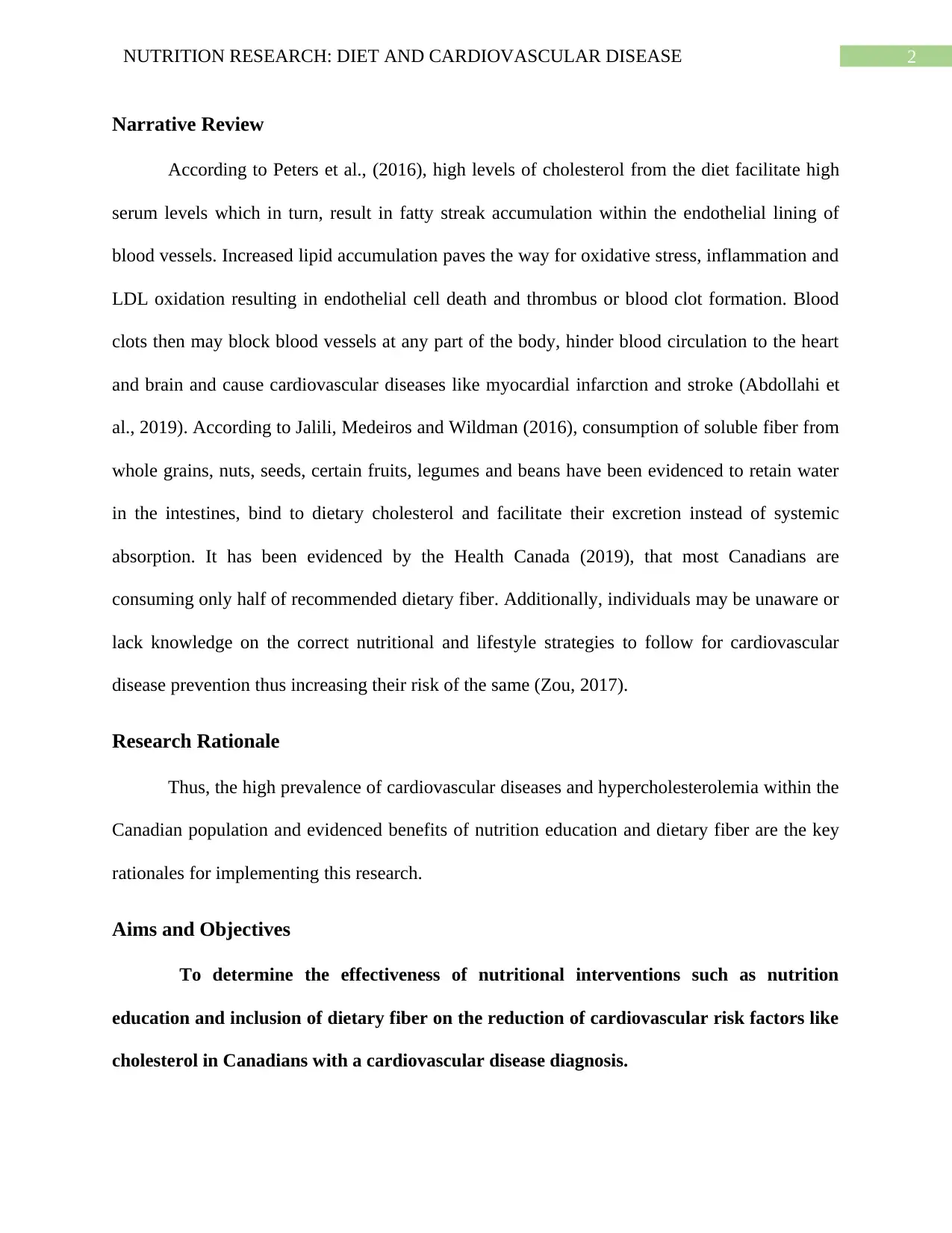
2NUTRITION RESEARCH: DIET AND CARDIOVASCULAR DISEASE
Narrative Review
According to Peters et al., (2016), high levels of cholesterol from the diet facilitate high
serum levels which in turn, result in fatty streak accumulation within the endothelial lining of
blood vessels. Increased lipid accumulation paves the way for oxidative stress, inflammation and
LDL oxidation resulting in endothelial cell death and thrombus or blood clot formation. Blood
clots then may block blood vessels at any part of the body, hinder blood circulation to the heart
and brain and cause cardiovascular diseases like myocardial infarction and stroke (Abdollahi et
al., 2019). According to Jalili, Medeiros and Wildman (2016), consumption of soluble fiber from
whole grains, nuts, seeds, certain fruits, legumes and beans have been evidenced to retain water
in the intestines, bind to dietary cholesterol and facilitate their excretion instead of systemic
absorption. It has been evidenced by the Health Canada (2019), that most Canadians are
consuming only half of recommended dietary fiber. Additionally, individuals may be unaware or
lack knowledge on the correct nutritional and lifestyle strategies to follow for cardiovascular
disease prevention thus increasing their risk of the same (Zou, 2017).
Research Rationale
Thus, the high prevalence of cardiovascular diseases and hypercholesterolemia within the
Canadian population and evidenced benefits of nutrition education and dietary fiber are the key
rationales for implementing this research.
Aims and Objectives
To determine the effectiveness of nutritional interventions such as nutrition
education and inclusion of dietary fiber on the reduction of cardiovascular risk factors like
cholesterol in Canadians with a cardiovascular disease diagnosis.
Narrative Review
According to Peters et al., (2016), high levels of cholesterol from the diet facilitate high
serum levels which in turn, result in fatty streak accumulation within the endothelial lining of
blood vessels. Increased lipid accumulation paves the way for oxidative stress, inflammation and
LDL oxidation resulting in endothelial cell death and thrombus or blood clot formation. Blood
clots then may block blood vessels at any part of the body, hinder blood circulation to the heart
and brain and cause cardiovascular diseases like myocardial infarction and stroke (Abdollahi et
al., 2019). According to Jalili, Medeiros and Wildman (2016), consumption of soluble fiber from
whole grains, nuts, seeds, certain fruits, legumes and beans have been evidenced to retain water
in the intestines, bind to dietary cholesterol and facilitate their excretion instead of systemic
absorption. It has been evidenced by the Health Canada (2019), that most Canadians are
consuming only half of recommended dietary fiber. Additionally, individuals may be unaware or
lack knowledge on the correct nutritional and lifestyle strategies to follow for cardiovascular
disease prevention thus increasing their risk of the same (Zou, 2017).
Research Rationale
Thus, the high prevalence of cardiovascular diseases and hypercholesterolemia within the
Canadian population and evidenced benefits of nutrition education and dietary fiber are the key
rationales for implementing this research.
Aims and Objectives
To determine the effectiveness of nutritional interventions such as nutrition
education and inclusion of dietary fiber on the reduction of cardiovascular risk factors like
cholesterol in Canadians with a cardiovascular disease diagnosis.
⊘ This is a preview!⊘
Do you want full access?
Subscribe today to unlock all pages.

Trusted by 1+ million students worldwide
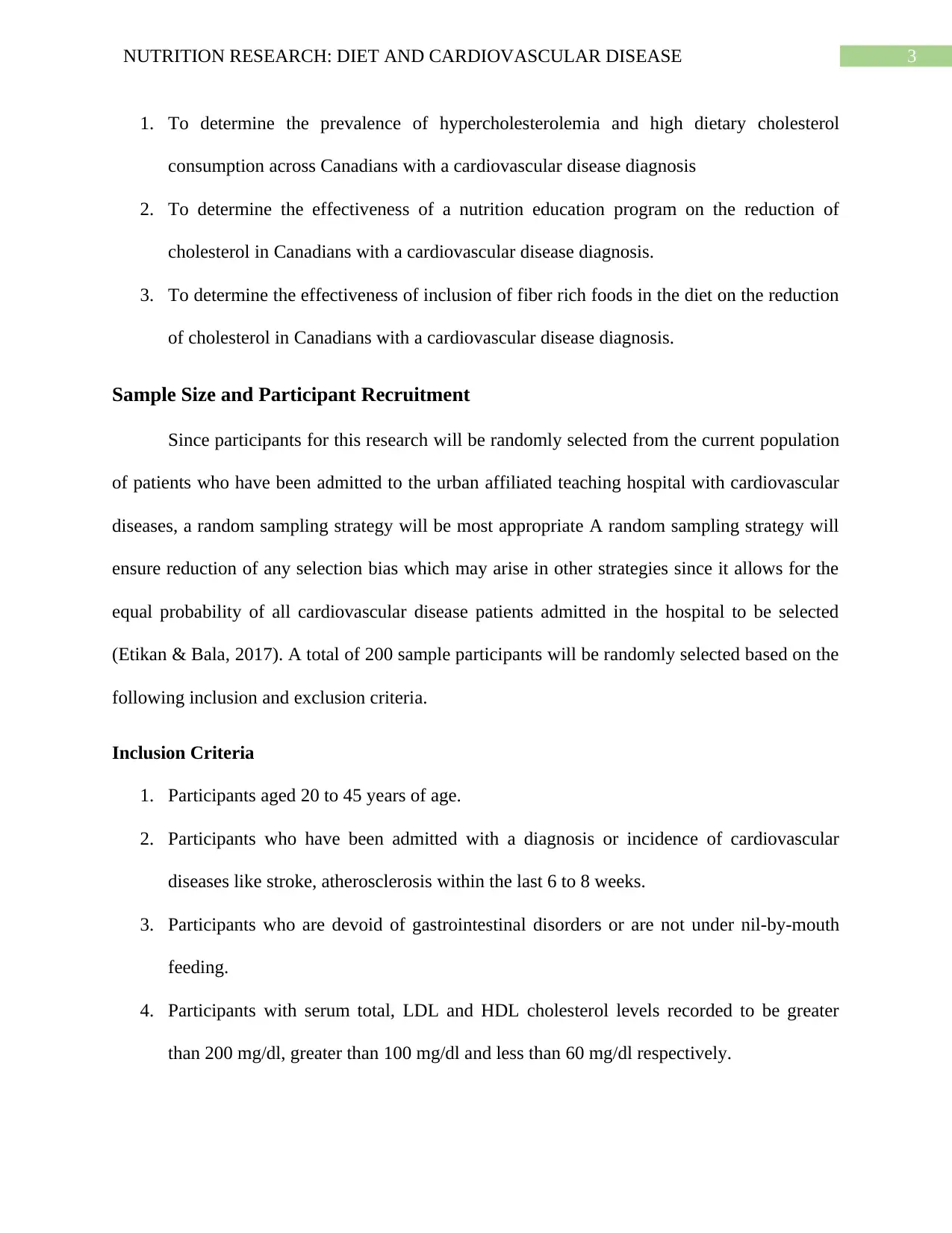
3NUTRITION RESEARCH: DIET AND CARDIOVASCULAR DISEASE
1. To determine the prevalence of hypercholesterolemia and high dietary cholesterol
consumption across Canadians with a cardiovascular disease diagnosis
2. To determine the effectiveness of a nutrition education program on the reduction of
cholesterol in Canadians with a cardiovascular disease diagnosis.
3. To determine the effectiveness of inclusion of fiber rich foods in the diet on the reduction
of cholesterol in Canadians with a cardiovascular disease diagnosis.
Sample Size and Participant Recruitment
Since participants for this research will be randomly selected from the current population
of patients who have been admitted to the urban affiliated teaching hospital with cardiovascular
diseases, a random sampling strategy will be most appropriate A random sampling strategy will
ensure reduction of any selection bias which may arise in other strategies since it allows for the
equal probability of all cardiovascular disease patients admitted in the hospital to be selected
(Etikan & Bala, 2017). A total of 200 sample participants will be randomly selected based on the
following inclusion and exclusion criteria.
Inclusion Criteria
1. Participants aged 20 to 45 years of age.
2. Participants who have been admitted with a diagnosis or incidence of cardiovascular
diseases like stroke, atherosclerosis within the last 6 to 8 weeks.
3. Participants who are devoid of gastrointestinal disorders or are not under nil-by-mouth
feeding.
4. Participants with serum total, LDL and HDL cholesterol levels recorded to be greater
than 200 mg/dl, greater than 100 mg/dl and less than 60 mg/dl respectively.
1. To determine the prevalence of hypercholesterolemia and high dietary cholesterol
consumption across Canadians with a cardiovascular disease diagnosis
2. To determine the effectiveness of a nutrition education program on the reduction of
cholesterol in Canadians with a cardiovascular disease diagnosis.
3. To determine the effectiveness of inclusion of fiber rich foods in the diet on the reduction
of cholesterol in Canadians with a cardiovascular disease diagnosis.
Sample Size and Participant Recruitment
Since participants for this research will be randomly selected from the current population
of patients who have been admitted to the urban affiliated teaching hospital with cardiovascular
diseases, a random sampling strategy will be most appropriate A random sampling strategy will
ensure reduction of any selection bias which may arise in other strategies since it allows for the
equal probability of all cardiovascular disease patients admitted in the hospital to be selected
(Etikan & Bala, 2017). A total of 200 sample participants will be randomly selected based on the
following inclusion and exclusion criteria.
Inclusion Criteria
1. Participants aged 20 to 45 years of age.
2. Participants who have been admitted with a diagnosis or incidence of cardiovascular
diseases like stroke, atherosclerosis within the last 6 to 8 weeks.
3. Participants who are devoid of gastrointestinal disorders or are not under nil-by-mouth
feeding.
4. Participants with serum total, LDL and HDL cholesterol levels recorded to be greater
than 200 mg/dl, greater than 100 mg/dl and less than 60 mg/dl respectively.
Paraphrase This Document
Need a fresh take? Get an instant paraphrase of this document with our AI Paraphraser
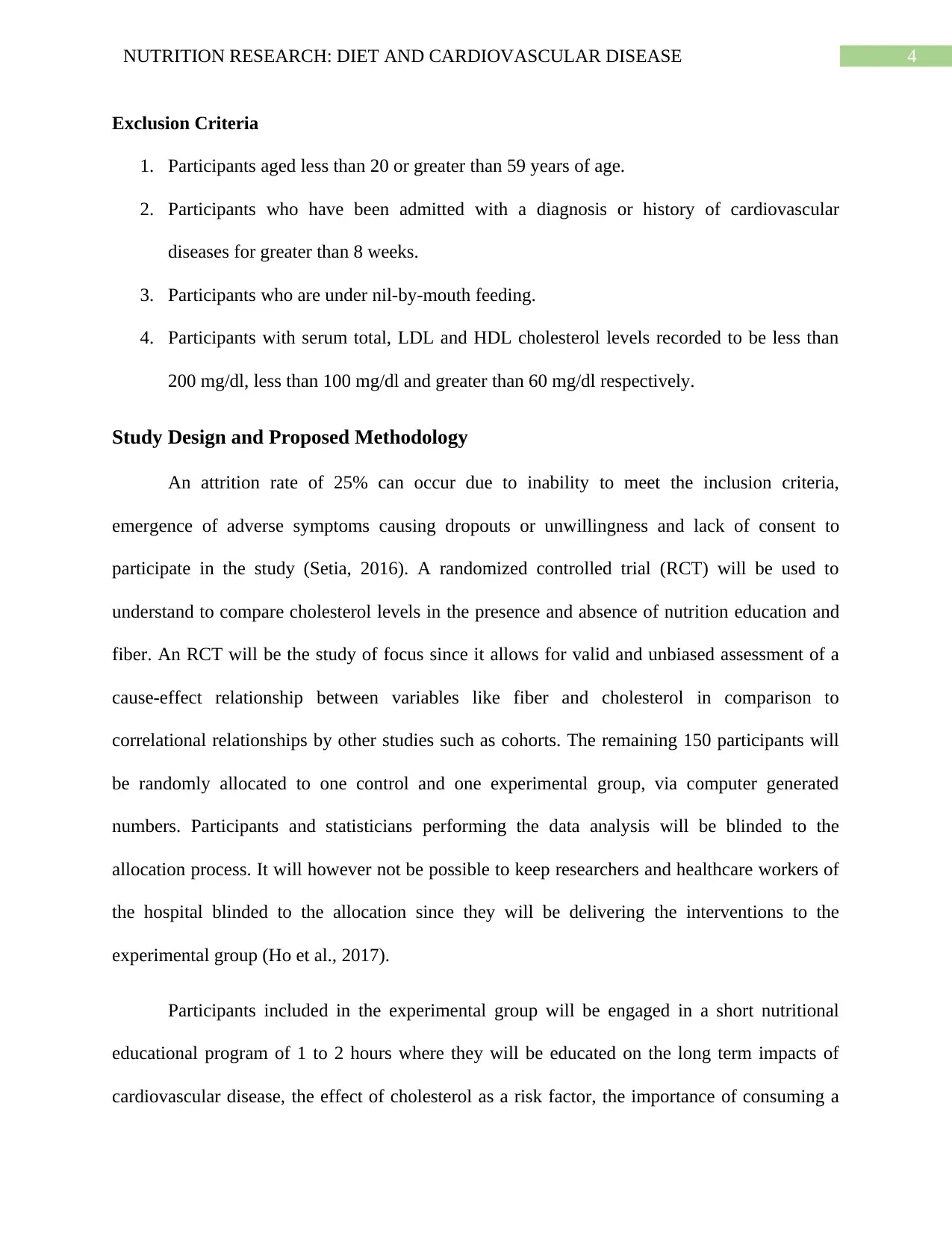
4NUTRITION RESEARCH: DIET AND CARDIOVASCULAR DISEASE
Exclusion Criteria
1. Participants aged less than 20 or greater than 59 years of age.
2. Participants who have been admitted with a diagnosis or history of cardiovascular
diseases for greater than 8 weeks.
3. Participants who are under nil-by-mouth feeding.
4. Participants with serum total, LDL and HDL cholesterol levels recorded to be less than
200 mg/dl, less than 100 mg/dl and greater than 60 mg/dl respectively.
Study Design and Proposed Methodology
An attrition rate of 25% can occur due to inability to meet the inclusion criteria,
emergence of adverse symptoms causing dropouts or unwillingness and lack of consent to
participate in the study (Setia, 2016). A randomized controlled trial (RCT) will be used to
understand to compare cholesterol levels in the presence and absence of nutrition education and
fiber. An RCT will be the study of focus since it allows for valid and unbiased assessment of a
cause-effect relationship between variables like fiber and cholesterol in comparison to
correlational relationships by other studies such as cohorts. The remaining 150 participants will
be randomly allocated to one control and one experimental group, via computer generated
numbers. Participants and statisticians performing the data analysis will be blinded to the
allocation process. It will however not be possible to keep researchers and healthcare workers of
the hospital blinded to the allocation since they will be delivering the interventions to the
experimental group (Ho et al., 2017).
Participants included in the experimental group will be engaged in a short nutritional
educational program of 1 to 2 hours where they will be educated on the long term impacts of
cardiovascular disease, the effect of cholesterol as a risk factor, the importance of consuming a
Exclusion Criteria
1. Participants aged less than 20 or greater than 59 years of age.
2. Participants who have been admitted with a diagnosis or history of cardiovascular
diseases for greater than 8 weeks.
3. Participants who are under nil-by-mouth feeding.
4. Participants with serum total, LDL and HDL cholesterol levels recorded to be less than
200 mg/dl, less than 100 mg/dl and greater than 60 mg/dl respectively.
Study Design and Proposed Methodology
An attrition rate of 25% can occur due to inability to meet the inclusion criteria,
emergence of adverse symptoms causing dropouts or unwillingness and lack of consent to
participate in the study (Setia, 2016). A randomized controlled trial (RCT) will be used to
understand to compare cholesterol levels in the presence and absence of nutrition education and
fiber. An RCT will be the study of focus since it allows for valid and unbiased assessment of a
cause-effect relationship between variables like fiber and cholesterol in comparison to
correlational relationships by other studies such as cohorts. The remaining 150 participants will
be randomly allocated to one control and one experimental group, via computer generated
numbers. Participants and statisticians performing the data analysis will be blinded to the
allocation process. It will however not be possible to keep researchers and healthcare workers of
the hospital blinded to the allocation since they will be delivering the interventions to the
experimental group (Ho et al., 2017).
Participants included in the experimental group will be engaged in a short nutritional
educational program of 1 to 2 hours where they will be educated on the long term impacts of
cardiovascular disease, the effect of cholesterol as a risk factor, the importance of consuming a
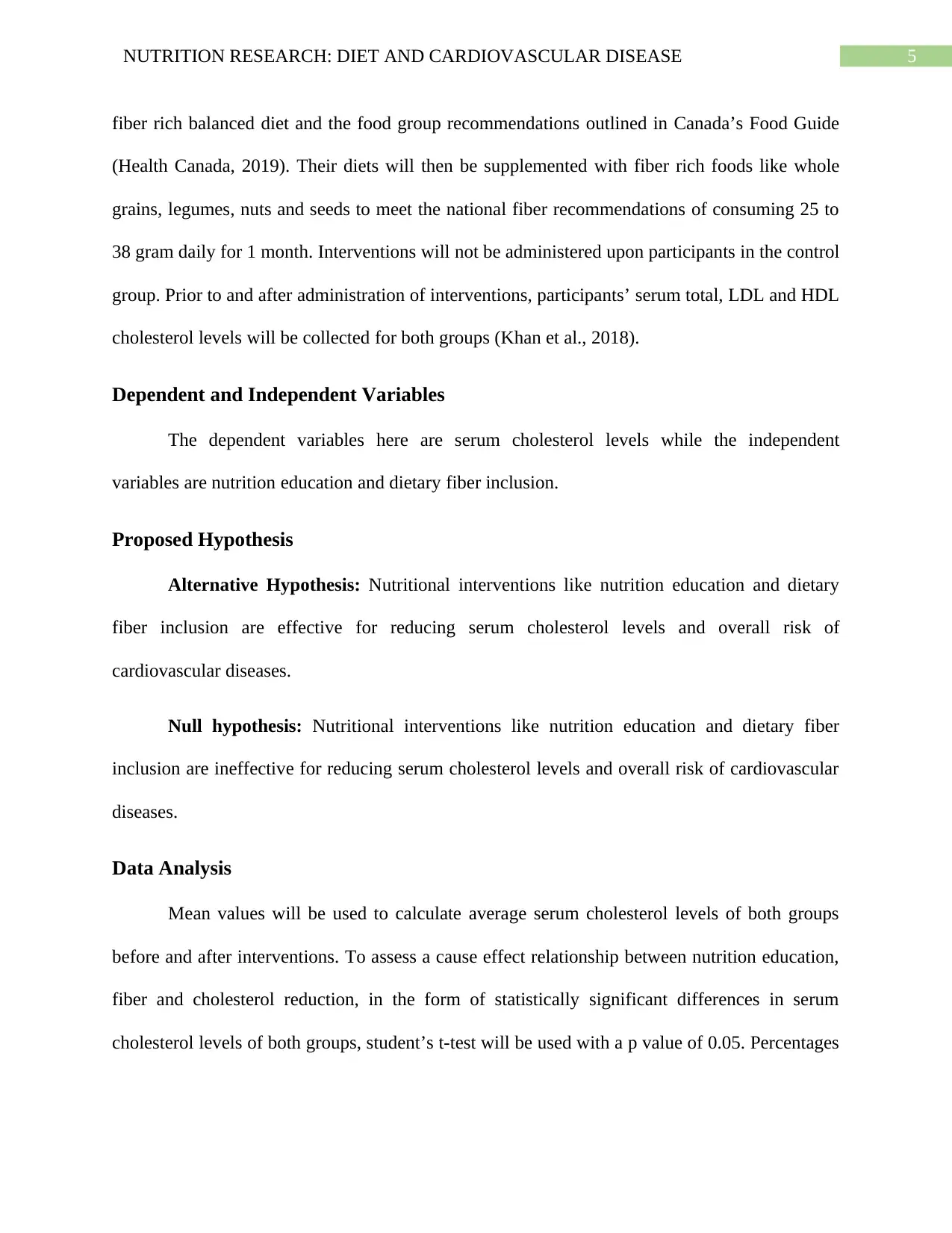
5NUTRITION RESEARCH: DIET AND CARDIOVASCULAR DISEASE
fiber rich balanced diet and the food group recommendations outlined in Canada’s Food Guide
(Health Canada, 2019). Their diets will then be supplemented with fiber rich foods like whole
grains, legumes, nuts and seeds to meet the national fiber recommendations of consuming 25 to
38 gram daily for 1 month. Interventions will not be administered upon participants in the control
group. Prior to and after administration of interventions, participants’ serum total, LDL and HDL
cholesterol levels will be collected for both groups (Khan et al., 2018).
Dependent and Independent Variables
The dependent variables here are serum cholesterol levels while the independent
variables are nutrition education and dietary fiber inclusion.
Proposed Hypothesis
Alternative Hypothesis: Nutritional interventions like nutrition education and dietary
fiber inclusion are effective for reducing serum cholesterol levels and overall risk of
cardiovascular diseases.
Null hypothesis: Nutritional interventions like nutrition education and dietary fiber
inclusion are ineffective for reducing serum cholesterol levels and overall risk of cardiovascular
diseases.
Data Analysis
Mean values will be used to calculate average serum cholesterol levels of both groups
before and after interventions. To assess a cause effect relationship between nutrition education,
fiber and cholesterol reduction, in the form of statistically significant differences in serum
cholesterol levels of both groups, student’s t-test will be used with a p value of 0.05. Percentages
fiber rich balanced diet and the food group recommendations outlined in Canada’s Food Guide
(Health Canada, 2019). Their diets will then be supplemented with fiber rich foods like whole
grains, legumes, nuts and seeds to meet the national fiber recommendations of consuming 25 to
38 gram daily for 1 month. Interventions will not be administered upon participants in the control
group. Prior to and after administration of interventions, participants’ serum total, LDL and HDL
cholesterol levels will be collected for both groups (Khan et al., 2018).
Dependent and Independent Variables
The dependent variables here are serum cholesterol levels while the independent
variables are nutrition education and dietary fiber inclusion.
Proposed Hypothesis
Alternative Hypothesis: Nutritional interventions like nutrition education and dietary
fiber inclusion are effective for reducing serum cholesterol levels and overall risk of
cardiovascular diseases.
Null hypothesis: Nutritional interventions like nutrition education and dietary fiber
inclusion are ineffective for reducing serum cholesterol levels and overall risk of cardiovascular
diseases.
Data Analysis
Mean values will be used to calculate average serum cholesterol levels of both groups
before and after interventions. To assess a cause effect relationship between nutrition education,
fiber and cholesterol reduction, in the form of statistically significant differences in serum
cholesterol levels of both groups, student’s t-test will be used with a p value of 0.05. Percentages
⊘ This is a preview!⊘
Do you want full access?
Subscribe today to unlock all pages.

Trusted by 1+ million students worldwide
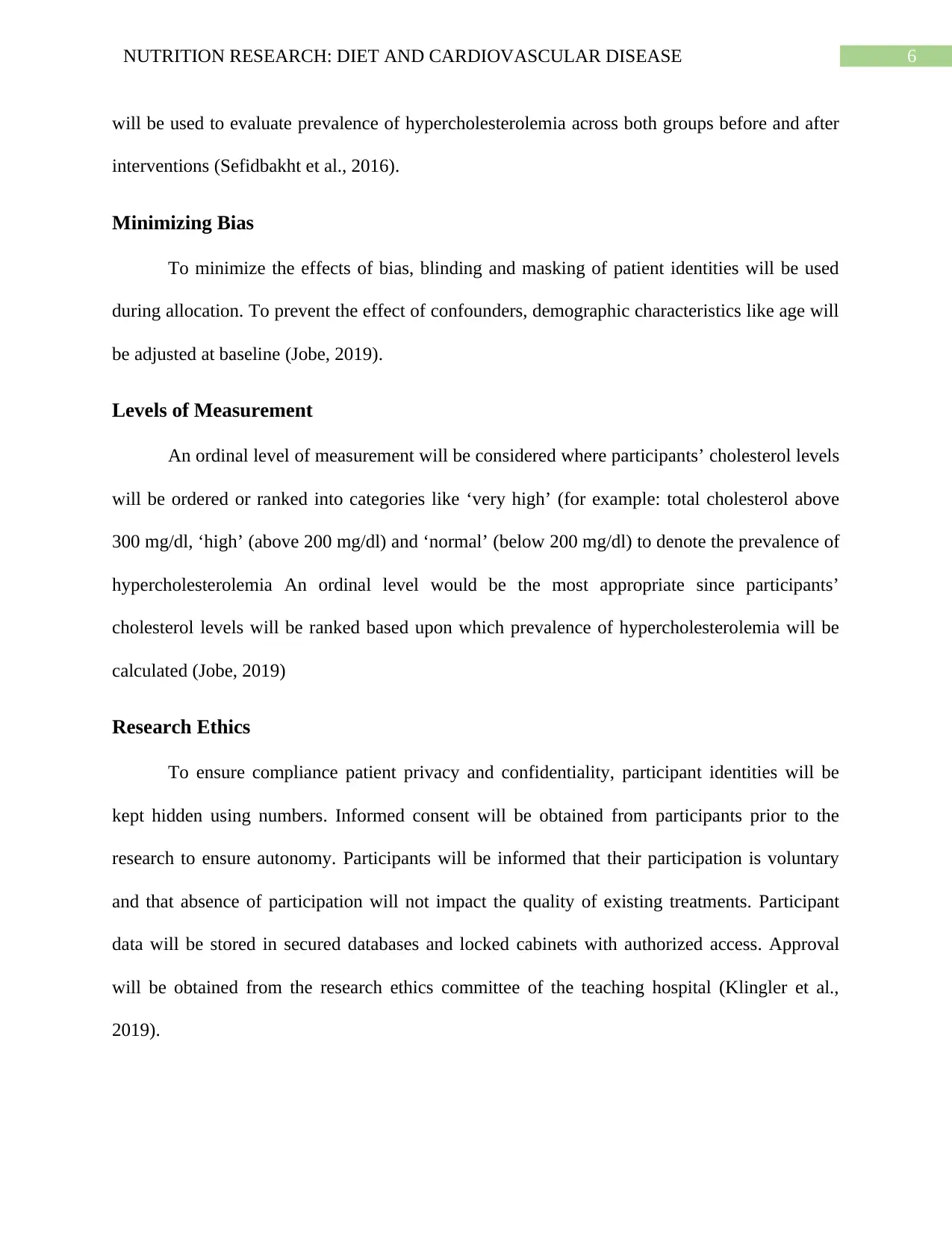
6NUTRITION RESEARCH: DIET AND CARDIOVASCULAR DISEASE
will be used to evaluate prevalence of hypercholesterolemia across both groups before and after
interventions (Sefidbakht et al., 2016).
Minimizing Bias
To minimize the effects of bias, blinding and masking of patient identities will be used
during allocation. To prevent the effect of confounders, demographic characteristics like age will
be adjusted at baseline (Jobe, 2019).
Levels of Measurement
An ordinal level of measurement will be considered where participants’ cholesterol levels
will be ordered or ranked into categories like ‘very high’ (for example: total cholesterol above
300 mg/dl, ‘high’ (above 200 mg/dl) and ‘normal’ (below 200 mg/dl) to denote the prevalence of
hypercholesterolemia An ordinal level would be the most appropriate since participants’
cholesterol levels will be ranked based upon which prevalence of hypercholesterolemia will be
calculated (Jobe, 2019)
Research Ethics
To ensure compliance patient privacy and confidentiality, participant identities will be
kept hidden using numbers. Informed consent will be obtained from participants prior to the
research to ensure autonomy. Participants will be informed that their participation is voluntary
and that absence of participation will not impact the quality of existing treatments. Participant
data will be stored in secured databases and locked cabinets with authorized access. Approval
will be obtained from the research ethics committee of the teaching hospital (Klingler et al.,
2019).
will be used to evaluate prevalence of hypercholesterolemia across both groups before and after
interventions (Sefidbakht et al., 2016).
Minimizing Bias
To minimize the effects of bias, blinding and masking of patient identities will be used
during allocation. To prevent the effect of confounders, demographic characteristics like age will
be adjusted at baseline (Jobe, 2019).
Levels of Measurement
An ordinal level of measurement will be considered where participants’ cholesterol levels
will be ordered or ranked into categories like ‘very high’ (for example: total cholesterol above
300 mg/dl, ‘high’ (above 200 mg/dl) and ‘normal’ (below 200 mg/dl) to denote the prevalence of
hypercholesterolemia An ordinal level would be the most appropriate since participants’
cholesterol levels will be ranked based upon which prevalence of hypercholesterolemia will be
calculated (Jobe, 2019)
Research Ethics
To ensure compliance patient privacy and confidentiality, participant identities will be
kept hidden using numbers. Informed consent will be obtained from participants prior to the
research to ensure autonomy. Participants will be informed that their participation is voluntary
and that absence of participation will not impact the quality of existing treatments. Participant
data will be stored in secured databases and locked cabinets with authorized access. Approval
will be obtained from the research ethics committee of the teaching hospital (Klingler et al.,
2019).
Paraphrase This Document
Need a fresh take? Get an instant paraphrase of this document with our AI Paraphraser
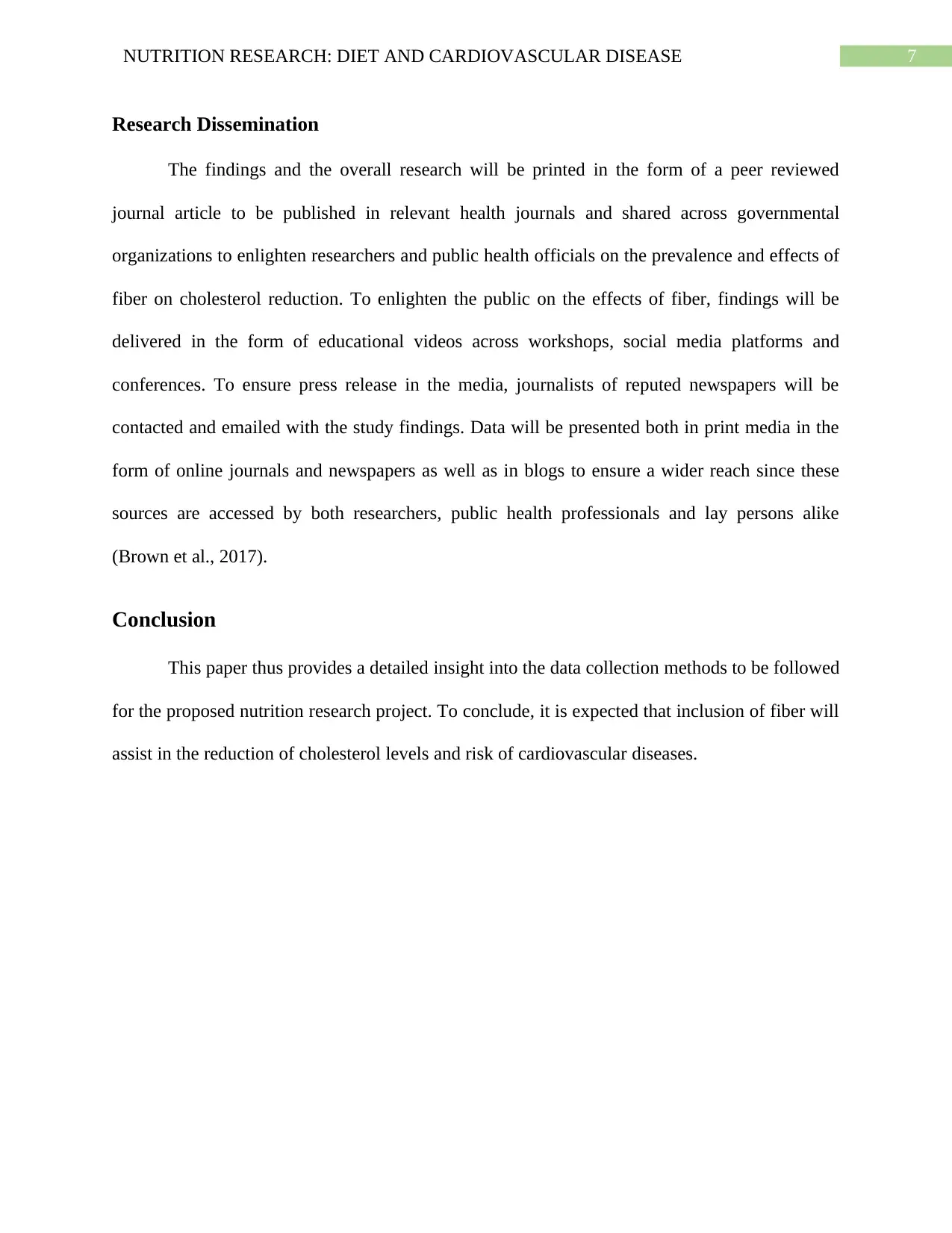
7NUTRITION RESEARCH: DIET AND CARDIOVASCULAR DISEASE
Research Dissemination
The findings and the overall research will be printed in the form of a peer reviewed
journal article to be published in relevant health journals and shared across governmental
organizations to enlighten researchers and public health officials on the prevalence and effects of
fiber on cholesterol reduction. To enlighten the public on the effects of fiber, findings will be
delivered in the form of educational videos across workshops, social media platforms and
conferences. To ensure press release in the media, journalists of reputed newspapers will be
contacted and emailed with the study findings. Data will be presented both in print media in the
form of online journals and newspapers as well as in blogs to ensure a wider reach since these
sources are accessed by both researchers, public health professionals and lay persons alike
(Brown et al., 2017).
Conclusion
This paper thus provides a detailed insight into the data collection methods to be followed
for the proposed nutrition research project. To conclude, it is expected that inclusion of fiber will
assist in the reduction of cholesterol levels and risk of cardiovascular diseases.
Research Dissemination
The findings and the overall research will be printed in the form of a peer reviewed
journal article to be published in relevant health journals and shared across governmental
organizations to enlighten researchers and public health officials on the prevalence and effects of
fiber on cholesterol reduction. To enlighten the public on the effects of fiber, findings will be
delivered in the form of educational videos across workshops, social media platforms and
conferences. To ensure press release in the media, journalists of reputed newspapers will be
contacted and emailed with the study findings. Data will be presented both in print media in the
form of online journals and newspapers as well as in blogs to ensure a wider reach since these
sources are accessed by both researchers, public health professionals and lay persons alike
(Brown et al., 2017).
Conclusion
This paper thus provides a detailed insight into the data collection methods to be followed
for the proposed nutrition research project. To conclude, it is expected that inclusion of fiber will
assist in the reduction of cholesterol levels and risk of cardiovascular diseases.
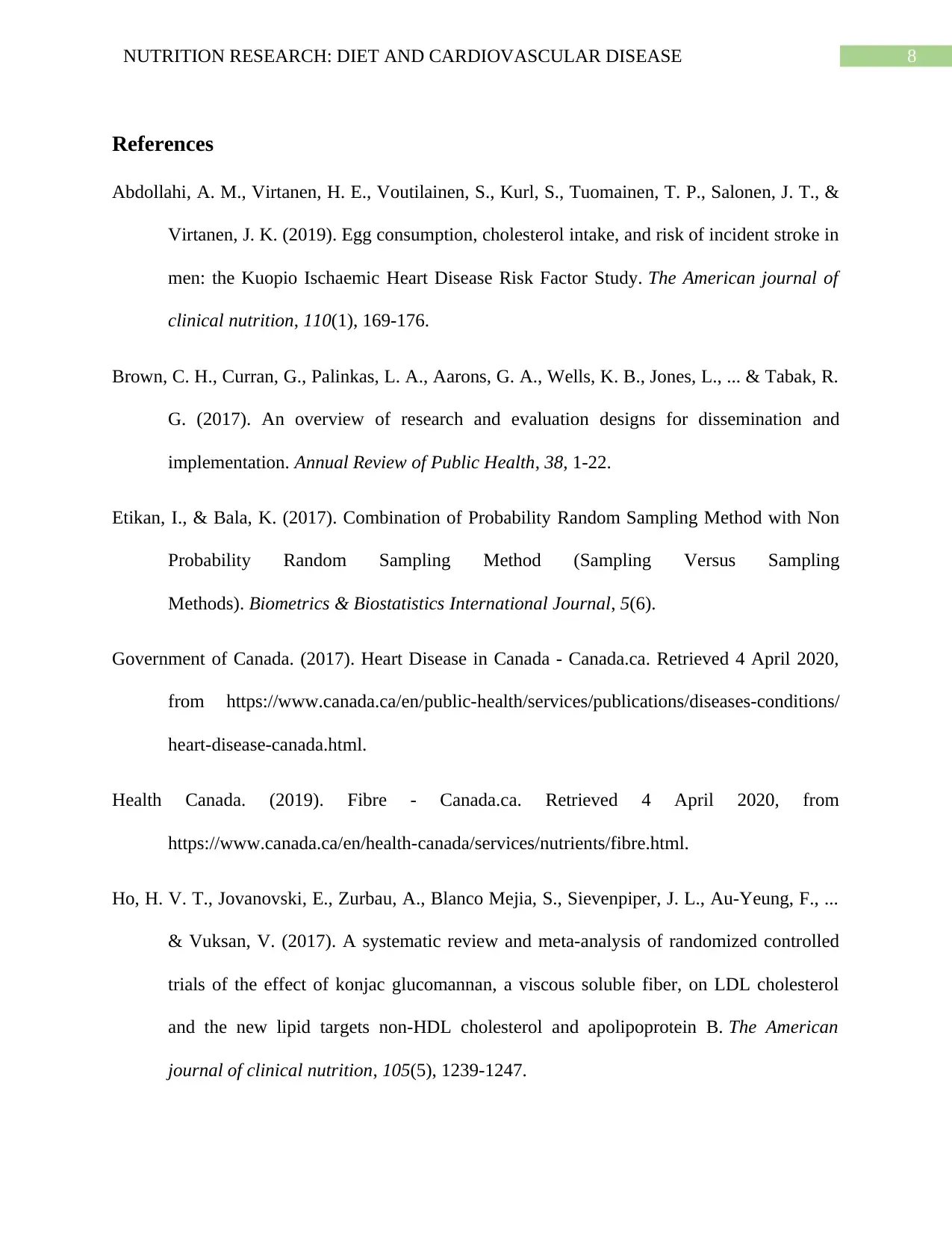
8NUTRITION RESEARCH: DIET AND CARDIOVASCULAR DISEASE
References
Abdollahi, A. M., Virtanen, H. E., Voutilainen, S., Kurl, S., Tuomainen, T. P., Salonen, J. T., &
Virtanen, J. K. (2019). Egg consumption, cholesterol intake, and risk of incident stroke in
men: the Kuopio Ischaemic Heart Disease Risk Factor Study. The American journal of
clinical nutrition, 110(1), 169-176.
Brown, C. H., Curran, G., Palinkas, L. A., Aarons, G. A., Wells, K. B., Jones, L., ... & Tabak, R.
G. (2017). An overview of research and evaluation designs for dissemination and
implementation. Annual Review of Public Health, 38, 1-22.
Etikan, I., & Bala, K. (2017). Combination of Probability Random Sampling Method with Non
Probability Random Sampling Method (Sampling Versus Sampling
Methods). Biometrics & Biostatistics International Journal, 5(6).
Government of Canada. (2017). Heart Disease in Canada - Canada.ca. Retrieved 4 April 2020,
from https://www.canada.ca/en/public-health/services/publications/diseases-conditions/
heart-disease-canada.html.
Health Canada. (2019). Fibre - Canada.ca. Retrieved 4 April 2020, from
https://www.canada.ca/en/health-canada/services/nutrients/fibre.html.
Ho, H. V. T., Jovanovski, E., Zurbau, A., Blanco Mejia, S., Sievenpiper, J. L., Au-Yeung, F., ...
& Vuksan, V. (2017). A systematic review and meta-analysis of randomized controlled
trials of the effect of konjac glucomannan, a viscous soluble fiber, on LDL cholesterol
and the new lipid targets non-HDL cholesterol and apolipoprotein B. The American
journal of clinical nutrition, 105(5), 1239-1247.
References
Abdollahi, A. M., Virtanen, H. E., Voutilainen, S., Kurl, S., Tuomainen, T. P., Salonen, J. T., &
Virtanen, J. K. (2019). Egg consumption, cholesterol intake, and risk of incident stroke in
men: the Kuopio Ischaemic Heart Disease Risk Factor Study. The American journal of
clinical nutrition, 110(1), 169-176.
Brown, C. H., Curran, G., Palinkas, L. A., Aarons, G. A., Wells, K. B., Jones, L., ... & Tabak, R.
G. (2017). An overview of research and evaluation designs for dissemination and
implementation. Annual Review of Public Health, 38, 1-22.
Etikan, I., & Bala, K. (2017). Combination of Probability Random Sampling Method with Non
Probability Random Sampling Method (Sampling Versus Sampling
Methods). Biometrics & Biostatistics International Journal, 5(6).
Government of Canada. (2017). Heart Disease in Canada - Canada.ca. Retrieved 4 April 2020,
from https://www.canada.ca/en/public-health/services/publications/diseases-conditions/
heart-disease-canada.html.
Health Canada. (2019). Fibre - Canada.ca. Retrieved 4 April 2020, from
https://www.canada.ca/en/health-canada/services/nutrients/fibre.html.
Ho, H. V. T., Jovanovski, E., Zurbau, A., Blanco Mejia, S., Sievenpiper, J. L., Au-Yeung, F., ...
& Vuksan, V. (2017). A systematic review and meta-analysis of randomized controlled
trials of the effect of konjac glucomannan, a viscous soluble fiber, on LDL cholesterol
and the new lipid targets non-HDL cholesterol and apolipoprotein B. The American
journal of clinical nutrition, 105(5), 1239-1247.
⊘ This is a preview!⊘
Do you want full access?
Subscribe today to unlock all pages.

Trusted by 1+ million students worldwide
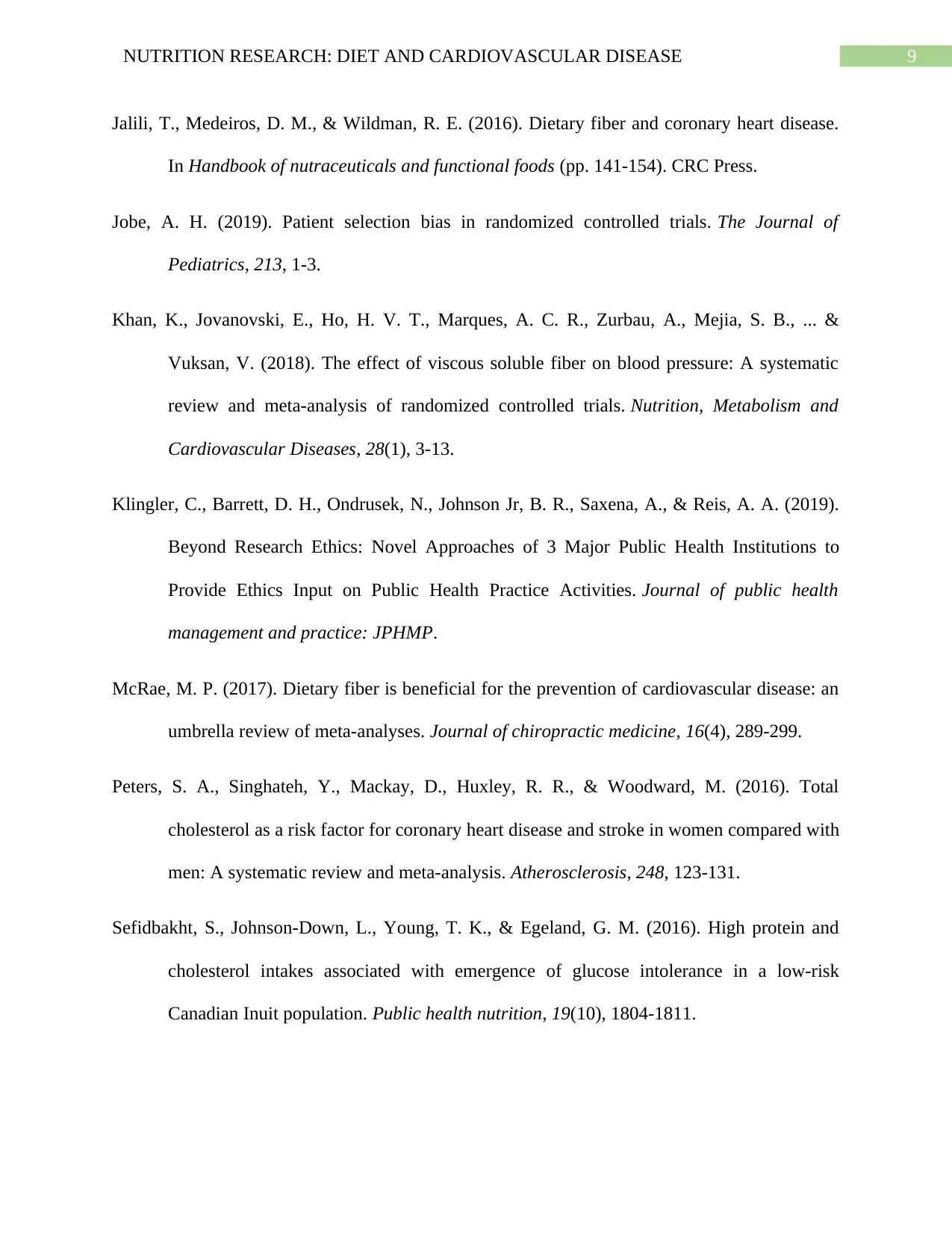
9NUTRITION RESEARCH: DIET AND CARDIOVASCULAR DISEASE
Jalili, T., Medeiros, D. M., & Wildman, R. E. (2016). Dietary fiber and coronary heart disease.
In Handbook of nutraceuticals and functional foods (pp. 141-154). CRC Press.
Jobe, A. H. (2019). Patient selection bias in randomized controlled trials. The Journal of
Pediatrics, 213, 1-3.
Khan, K., Jovanovski, E., Ho, H. V. T., Marques, A. C. R., Zurbau, A., Mejia, S. B., ... &
Vuksan, V. (2018). The effect of viscous soluble fiber on blood pressure: A systematic
review and meta-analysis of randomized controlled trials. Nutrition, Metabolism and
Cardiovascular Diseases, 28(1), 3-13.
Klingler, C., Barrett, D. H., Ondrusek, N., Johnson Jr, B. R., Saxena, A., & Reis, A. A. (2019).
Beyond Research Ethics: Novel Approaches of 3 Major Public Health Institutions to
Provide Ethics Input on Public Health Practice Activities. Journal of public health
management and practice: JPHMP.
McRae, M. P. (2017). Dietary fiber is beneficial for the prevention of cardiovascular disease: an
umbrella review of meta-analyses. Journal of chiropractic medicine, 16(4), 289-299.
Peters, S. A., Singhateh, Y., Mackay, D., Huxley, R. R., & Woodward, M. (2016). Total
cholesterol as a risk factor for coronary heart disease and stroke in women compared with
men: A systematic review and meta-analysis. Atherosclerosis, 248, 123-131.
Sefidbakht, S., Johnson-Down, L., Young, T. K., & Egeland, G. M. (2016). High protein and
cholesterol intakes associated with emergence of glucose intolerance in a low-risk
Canadian Inuit population. Public health nutrition, 19(10), 1804-1811.
Jalili, T., Medeiros, D. M., & Wildman, R. E. (2016). Dietary fiber and coronary heart disease.
In Handbook of nutraceuticals and functional foods (pp. 141-154). CRC Press.
Jobe, A. H. (2019). Patient selection bias in randomized controlled trials. The Journal of
Pediatrics, 213, 1-3.
Khan, K., Jovanovski, E., Ho, H. V. T., Marques, A. C. R., Zurbau, A., Mejia, S. B., ... &
Vuksan, V. (2018). The effect of viscous soluble fiber on blood pressure: A systematic
review and meta-analysis of randomized controlled trials. Nutrition, Metabolism and
Cardiovascular Diseases, 28(1), 3-13.
Klingler, C., Barrett, D. H., Ondrusek, N., Johnson Jr, B. R., Saxena, A., & Reis, A. A. (2019).
Beyond Research Ethics: Novel Approaches of 3 Major Public Health Institutions to
Provide Ethics Input on Public Health Practice Activities. Journal of public health
management and practice: JPHMP.
McRae, M. P. (2017). Dietary fiber is beneficial for the prevention of cardiovascular disease: an
umbrella review of meta-analyses. Journal of chiropractic medicine, 16(4), 289-299.
Peters, S. A., Singhateh, Y., Mackay, D., Huxley, R. R., & Woodward, M. (2016). Total
cholesterol as a risk factor for coronary heart disease and stroke in women compared with
men: A systematic review and meta-analysis. Atherosclerosis, 248, 123-131.
Sefidbakht, S., Johnson-Down, L., Young, T. K., & Egeland, G. M. (2016). High protein and
cholesterol intakes associated with emergence of glucose intolerance in a low-risk
Canadian Inuit population. Public health nutrition, 19(10), 1804-1811.
Paraphrase This Document
Need a fresh take? Get an instant paraphrase of this document with our AI Paraphraser
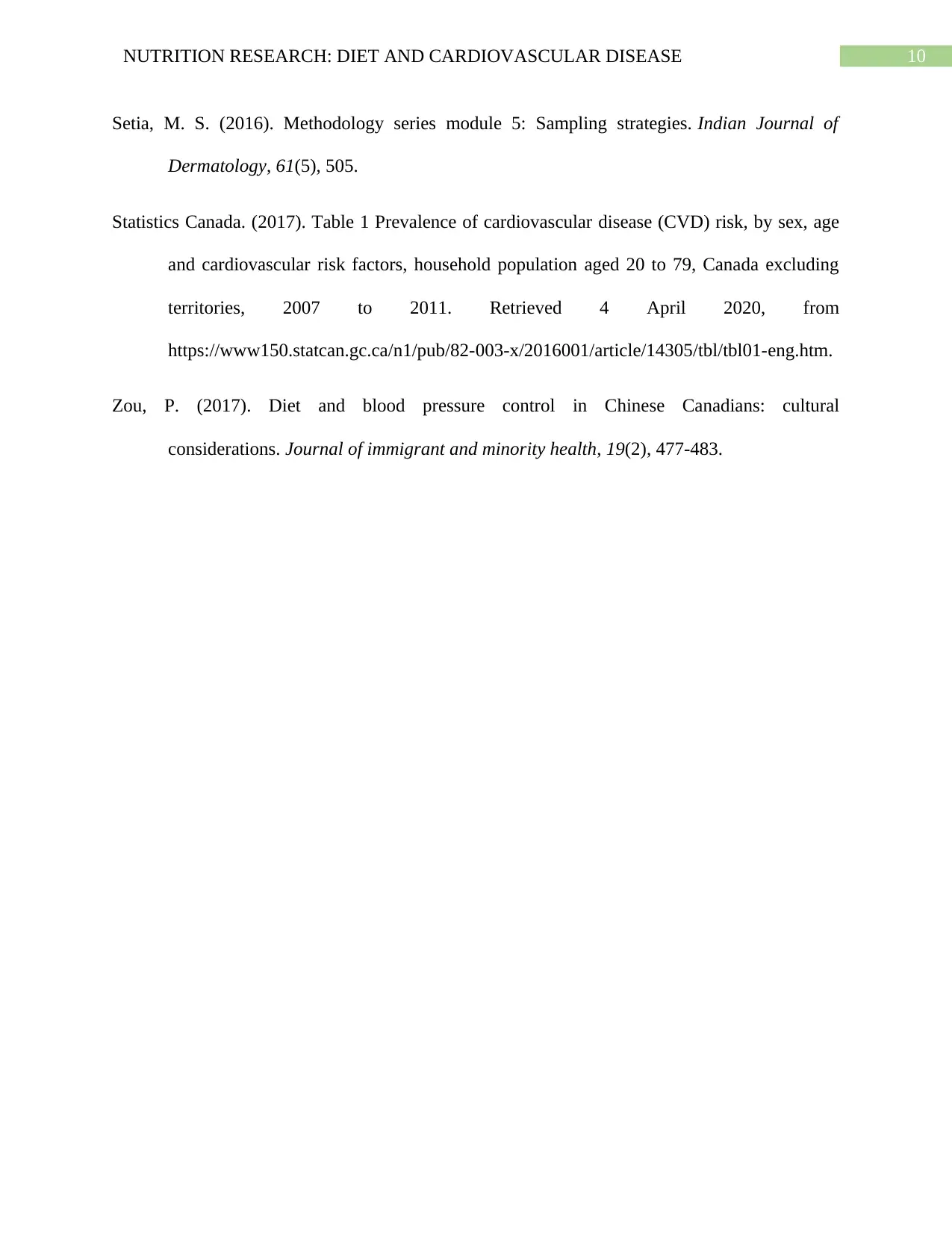
10NUTRITION RESEARCH: DIET AND CARDIOVASCULAR DISEASE
Setia, M. S. (2016). Methodology series module 5: Sampling strategies. Indian Journal of
Dermatology, 61(5), 505.
Statistics Canada. (2017). Table 1 Prevalence of cardiovascular disease (CVD) risk, by sex, age
and cardiovascular risk factors, household population aged 20 to 79, Canada excluding
territories, 2007 to 2011. Retrieved 4 April 2020, from
https://www150.statcan.gc.ca/n1/pub/82-003-x/2016001/article/14305/tbl/tbl01-eng.htm.
Zou, P. (2017). Diet and blood pressure control in Chinese Canadians: cultural
considerations. Journal of immigrant and minority health, 19(2), 477-483.
Setia, M. S. (2016). Methodology series module 5: Sampling strategies. Indian Journal of
Dermatology, 61(5), 505.
Statistics Canada. (2017). Table 1 Prevalence of cardiovascular disease (CVD) risk, by sex, age
and cardiovascular risk factors, household population aged 20 to 79, Canada excluding
territories, 2007 to 2011. Retrieved 4 April 2020, from
https://www150.statcan.gc.ca/n1/pub/82-003-x/2016001/article/14305/tbl/tbl01-eng.htm.
Zou, P. (2017). Diet and blood pressure control in Chinese Canadians: cultural
considerations. Journal of immigrant and minority health, 19(2), 477-483.
1 out of 11
Your All-in-One AI-Powered Toolkit for Academic Success.
+13062052269
info@desklib.com
Available 24*7 on WhatsApp / Email
![[object Object]](/_next/static/media/star-bottom.7253800d.svg)
Unlock your academic potential
Copyright © 2020–2025 A2Z Services. All Rights Reserved. Developed and managed by ZUCOL.